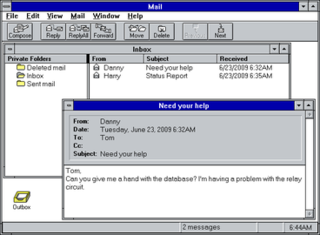The Simple Mail Transfer Protocol (SMTP) is an Internet standard communication protocol for electronic mail transmission. Mail servers and other message transfer agents use SMTP to send and receive mail messages. User-level email clients typically use SMTP only for sending messages to a mail server for relaying, and typically submit outgoing email to the mail server on port 587 or 465 per RFC 8314. For retrieving messages, IMAP is standard, but proprietary servers also often implement proprietary protocols, e.g., Exchange ActiveSync.

The Maildir e-mail format is a common way of storing email messages on a file system, rather than in a database. Each message is assigned a file with a unique name, and each mail folder is a file system directory containing these files. Maildir was designed by Daniel J. Bernstein circa 1995, with a major goal of eliminating the need for program code to handle file locking and unlocking through use of the local filesystem. Maildir design reflects the fact that the only operations valid for an email message is that it be created, deleted or have its status changed in some way.
A mail exchanger record specifies the mail server responsible for accepting email messages on behalf of a domain name. It is a resource record in the Domain Name System (DNS). It is possible to configure several MX records, typically pointing to an array of mail servers for load balancing and redundancy.

GNOME Evolution is the official personal information manager for GNOME. It has been an official part of GNOME since Evolution 2.0 was included with the GNOME 2.8 release in September 2004. It combines e-mail, address book, calendar, task list and note-taking features. Its user interface and functionality is similar to Microsoft Outlook. Evolution is free software licensed under the terms of the GNU Lesser General Public License (LGPL).
qmail is a mail transfer agent (MTA) that runs on Unix. It was written, starting December 1995, by Daniel J. Bernstein as a more secure alternative to the popular Sendmail program. Originally license-free software, qmail's source code was later dedicated to the public domain by the author.
An email address identifies an email box to which messages are delivered. While early messaging systems used a variety of formats for addressing, today, email addresses follow a set of specific rules originally standardized by the Internet Engineering Task Force (IETF) in the 1980s, and updated by RFC 5322 and 6854. The term email address in this article refers to just the addr-spec in Section 3.4 of RFC 5322. The RFC defines address more broadly as either a mailbox or group. A mailbox value can be either a name-addr, which contains a display-name and addr-spec, or the more common addr-spec alone.
Greylisting is a method of defending e-mail users against spam. A mail transfer agent (MTA) using greylisting will "temporarily reject" any email from a sender it does not recognize. If the mail is legitimate, the originating server will try again after a delay, and if sufficient time has elapsed, the email will be accepted.
MMDF, the Multichannel Memorandum Distribution Facility, is a message transfer agent (MTA), a computer program designed to transmit email.

Postfix is a free and open-source mail transfer agent (MTA) that routes and delivers electronic mail.

Microsoft Mail was the name given to several early Microsoft e-mail products for local area networks, primarily two architectures: one for Macintosh networks, and one for PC architecture-based LANs. All were eventually replaced by the Exchange and Outlook product lines.
Variable envelope return path (VERP) is a technique used by some electronic mailing list software to enable automatic detection and removal of undeliverable e-mail addresses. It works by using a different return path for each recipient of a message.
The UW IMAP server was the reference server implementation of the Internet Message Access Protocol. It was developed at the University of Washington by Mark Crispin and others.
The comparison of mail servers covers mail transfer agents (MTAs), mail delivery agents, and other computer software that provide e-mail services.
Opportunistic TLS refers to extensions in plain text communication protocols, which offer a way to upgrade a plain text connection to an encrypted connection instead of using a separate port for encrypted communication. Several protocols use a command named "STARTTLS" for this purpose. It is a form of opportunistic encryption and is primarily intended as a countermeasure to passive monitoring.
Email forwarding generically refers to the operation of re-sending a previously delivered email to an email address to one or more different email addresses.
The Courier Mail Server is a mail transfer agent (MTA) server that provides SMTP, IMAP, POP3, SMAP, webmail, and mailing list services with individual components. It is best known for its IMAP server component.
Smail-3 is a mail transfer agent (MTA) used on Unix-like operating systems. It is Free Software and is licensed under the GNU GPL. It aims to be a general and flexible mailer with extensive facilities for checking incoming e-mail and for routing between disparate networks. It is still in use on the Internet, but it has been mostly superseded by Exim and other more modern mail transfer agents.
Philip Hazel is a computer programmer best known for writing the Exim mail transport agent in 1995 and the PCRE regular expression library in 1997.
Amavis is an open-source content filter for electronic mail, implementing mail message transfer, decoding, some processing and checking, and interfacing with external content filters to provide protection against spam and viruses and other malware. It can be considered an interface between a mailer and one or more content filters.




